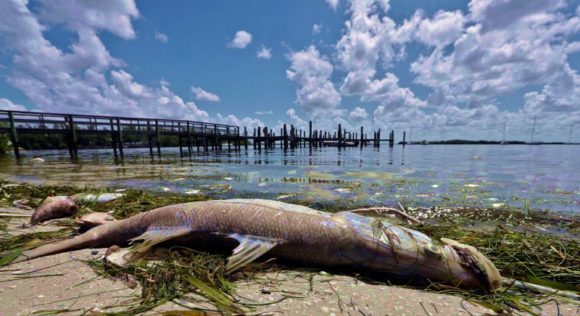
Photo: The Earther.
By Alexandra Kelly
ABSTRACT
Harmful algal blooms along the Gulf Coast of Florida have been increasing in size, duration, and frequency. They are caused by an influx of nutrients into the ecosystem which stimulated the growth of the organism Karenia brevis. The blooms use up the oxygen in the water, killing the majority of marine life, and release toxins into the water and air that affect humans. These blooms cost Florida millions of dollars between their impact on tourism, commercial activity, and human health. Research indicates that the influx of nutrients into the environment is caused by agricultural activity. The fertilizers used wash into waterways which lead into the ocean. By encouraging the use of a nitrogen inhibitor and the practice of tilling agricultural land, the amount of nutrients entering the waterways is greatly reduced. This will prevent the scope of blooms that have been seen most recently in the summer of 2018. Additionally, public education about the blooms is necessary to prevent health related impacts and bring awareness to the issue. These two practices reduce the overall cost of the harmful algal blooms on Florida’s society.
INTRODUCTION
RECENT HARMFUL ALGAL BLOOMS IN FLORIDA
Algal blooms are naturally occurring phenomena in which microorganisms grow at an increased rate due to some trigger factor. However, human eutrophication and interference worsens the frequency and duration of the harmful algal blooms. In Florida, the dinoflagellate, Karenia brevis, is the organism that most commonly causes the phenomena. This creature has a red pigmentation responsible for the nickname “red tide”. It was the cause of the most recent severe blooms in August 2018 (Serrano, 2018). Average concentrations of this organism are approximately 1,000 cells per liter of water. When the concentration increases to 1 million cells per liter, the bloom kills all other life in the area. The August 2018 concentrations were up to 50 million cells per liter of water (Serrano, 2018). Appendix A illustrates the levels of the Karenia brevis in the water along Florida’s Gulf Coast from July 31st to August 7th in 2018. The red dots indicate a concentration of over 1 million cells per liter of water. This past bloom was so severe that it caused former governor Rick Scott to declare a state of emergency in seven counties K. brevis is a toxic organism, releasing these toxins into its surrounding environment. They cause commercially vital animals such as shrimp and fish to die off.
Figure 1: The Increasing Trend of Harmful Algal Blooms
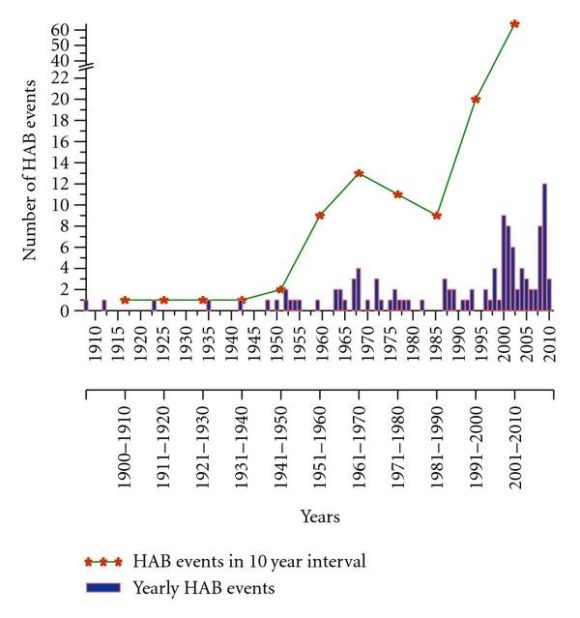 Padmakumar, K.B., Menon, N. R., & Sanjeevan, V. N., 2012
Padmakumar, K.B., Menon, N. R., & Sanjeevan, V. N., 2012
Harmful algal blooms have been worsening worldwide, with a sharp increase in events in the past twenty-five years. This data is shown in Figure 1. By examining the ten-year trend in green, it can be seen that up until 1950, there was an average of one harmful algal bloom per year. However, this amount increased to thirteen events per year in 1970, decreased slightly, and then increased to over sixty blooms per year by 2010. This trend indicates that the amount of harmful algal blooms will only increase in the future (Padmakumar, K.B., Menon, N. R., & Sanjeevan, V. N., 2012).
HARMFUL ALGAL BLOOMS’ IMPACT ON HEALTH
Although many marine species get killed by the blooms, certain mollusks and shellfish such as clams and oysters are not affected in this way. These organisms are filter feeders, siphoning water from the environment to strain out their microorganism prey. These microorganism prey species include dinoflagellates such as the Karenia brevis. During the blooms, these animals filter the toxins, called brevetoxins from the Karenia brevis organism, in the water which accumulates in their tissues. Much like other chemicals in the water, such as mercury, bioaccumulation causes the concentration of toxins in their tissues to be significantly higher than the concentration in the water. The Food and Drug Administration limit for these toxins in shellfish is 20 MU/100 grams of shellfish tissue. When shellfish are over this amount, they pose a threat to humans (Watkins, Reich, Fleming, & Hammond, 2008).
When these contaminated shellfish are consumed by humans, they can cause paralytic, diarrhetic, neurotoxic, or amnesic shellfish poisoning (Anderson, 2005). The symptoms of these conditions can include gastro-intestinal issues, coordination problems, seizures and convulsions, and partial paralysis. There has only been one death associated with this issue; paralytic shellfish poisoning caused the death of an Alaskan. These conditions have the potential to be deadly; however, the one death is not included in the health impacts as it is specific to Florida. For neurotoxic shellfish poisoning alone, there were twenty-four cases reported over a five-year period in Florida with many going unreported due to misdiagnoses and lack of medical care received (Reich et. al., 2015). The shellfish harvesting areas are closed to commercial activity during severe blooms and are not reopened until the concentration of Karenia brevis in the water is under 5,000 cells per liter of water and when shellfish tissues have a brevetoxin concentration of less than 20 MU per 100 gram of tissue (Watkins, Reich, Fleming, & Hammond, 2008). Despite the closures of the shellfish harvesting areas, cases of shellfish poisoning from harmful algal blooms still occur due to lack of outreach and education of recreational harvesters, tourists and visitors, and the language barrier between non-English speakers and official notices (Reich et. al., 2015).
urthermore, K. brevis blooms can affect those that do not consume shellfish or do not enter the water in the contaminated area. K. brevis is a relatively fragile organism and its cell is easily broken by wave and wind energy. The broken cells release more toxins into the water and these released brevetoxins can be aerosolized, mixing with the coastal winds. The winds carry the toxin into beachside areas, affecting the residents and visitors of those areas. They cause respiratory reactions such as throat irritation, sneezing, coughing, and a burning sensation in the throat. For people with pre-existing respiratory conditions such as asthma, these toxic winds can cause a statistically significant increase in asthmatic symptoms and decrease in pulmonary function (Watkins, Reich, Fleming, & Hammond, 2008). Both of these aspects contribute to the cost of the blooms with respect to medical treatment and hospitalization.
HARMFUL ALGAL BLOOMS’ IMPACT ON THE FLORIDA ECONOMY
Hoagland, Anderson, Kaoru, and White estimate in their 2002 paper “The Economic Effects of Harmful Algal Blooms in the United States: Estimates, Assessment Issues, and Information Needs” that each case of paralytic shellfish poisoning costs $1,400 if reported and $1,100 if unreported. These figures include the cost of medical treatment, investigations of cause, and lost productivity due to sick days. Accounting for inflation, currently the cost of a reported case would be approximately $1,950 and an unreported case would be $1,550. In Florida, shellfish harvesting areas are closed by authorities when K. brevis concentrations reach 5,000 cells per liter of water or greater.
Harmful algal blooms affect commercial fisheries through direct mortalities, habitat loss, decreasing carrying capacity, causing harvesting area closures, and decreasing consumer demands. The average impact of these was $12 million throughout the United States by 2002, approximating almost $17 million in 2018 (Hoagland, Anderson, Kaoru, & White, 2002). However, the blooms have the potential to incur a greater cost depending on location, duration, and severity. With regards to tourism, economic impact on Florida’s Gulf coast is still being calculated from the most recent blooms. The closest comparison can be drawn from the economic impact on four counties in a North Carolina community in 1987. The cost from tourism and recreation alone was $29 million, which is over $64 million today (Hoagland, Anderson, Kaoru, & White, 2002). It should be noted that the algal blooms caused a state of emergency in seven counties in Florida in August 2018, which is much larger in scope than the 1987 North Carolina bloom.
| Tourism | Commercial Activity | Health | Cleanup Efforts | Total | |
|---|---|---|---|---|---|
| Cost | $20,000,000 | $800,000 | $30,800,000 | $515,000 | $52,115,000 |
Figure 2 depicts the separate costs of harmful algal blooms on Florida’s economy due to their impacts on tourism, commercial activity, health, and cleanup efforts. Tourism includes the effects on hotels, beaches, and beachside business revenues. Although studies indicate that this cost could be upwards of $64 million, a conservative estimate indicates that $20 million would be more applicable for this model due to its overlap with recreational and commercial activities. This figure also depends on the severity and specific location of the bloom (Hoagland, Anderson, Kaoru, & White, 2002). Commercial activity includes the impacts on shellfish harvesting, commercial fishing, and other activities that take from the environment for human consumption. This is also a conservative estimate of $800,000 depending on the area effected (Anderson, Hoagland, Kaoru, & White, 2000). Health impacts, $30,800,000, includes the costs of shellfish poisoning cases as well as the increased respiratory issues that people experience from aerosolized brevetoxins (Morgan, Larkin, & Adams, 2007). Lastly, there is the cost of current remediation practices which almost exclusively consists of cleanup efforts. This figure, $515,000, includes salaries for cleanup and monitoring professionals (Hoagland, Anderson, Kaoru, & White, 2002). The total of all of these categories is approximately $52 million per year in the state of Florida alone.
HOW HARMFUL ALGAL BLOOMS FORM
As mentioned previously, normal concentrations of Karenia brevis in Florida is approximately 1,000 cells per liter of water (Serrano, 2018). Nutrients such as nitrogen and phosphorous are introduced into the environment through waterways that stimulate the cells to increase in productivity. Because of the geography of Florida, the Gulf coast is prone to influxes of nutrients from its hundreds of canals and inland waterways. When the Karenia brevis comes into contact with the nutrients, the organisms’ cells grow and divide exponentially. Over a quick period of time, the initial amount of cells multiple and explode in population. Sustained nutrients continue to aggravate the bloom, leading to concentrations of over 1 million cells per liter of water (Serrano, 2018). At this point, the bloom kills almost every living creature in the surrounding area. It not only does this by excreting toxins, but also by using a large percentage of the dissolved oxygen in the water which causes hypoxic conditions. The bodies of marine life wash onto beachside areas, causing a foul smell and an eyesore to an otherwise attractive area.
CAUSES OF ALGAL BLOOMS
Although harmful algal blooms are naturally occurring under normal environmental conditions, human anthropogenic interference impacts their scope and scale. Eutrophic conditions are a precondition needed for sustained algal blooms. Eutrophication is also a naturally occurring phenomena that has been affected by human practices. In the marine environment, eutrophication can occur in upwelling areas, zones where winds blow in a specific direction causing nutrients from the ocean bottom to circulate upwards. Despite this, upwelling zones are very well defined and Florida is not an area known for this unlike places such as California, Washington, and Oregon. Because the influx of nutrients cannot be explained by natural factors, anthropogenic causes have been analyzed for their role in this issue.
Figure 3: Eutrophication from Nitrogen and Phosphorous
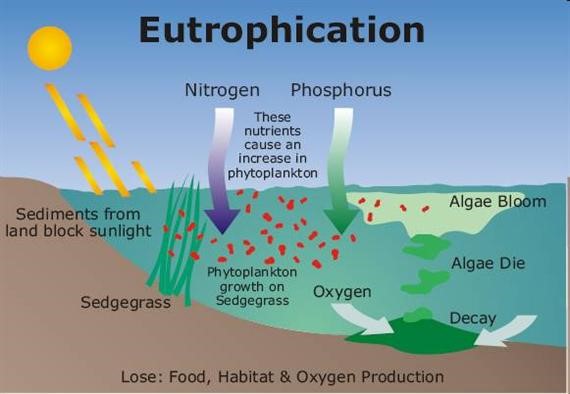
Image from Ecological Engineering in the Tropics https://cr2014studyabroad.wordpress.com/daily-topic-updates/eutrophication-tiffany/
Industry, agriculture, and sewage run off contribute to the nutrient loading of waterways. Fertilizers, rich in nitrogen and phosphorous, are pointed to as a significant source of these nutrients (Anderson, 2005). The scientific consensus states that increased nutrient pollution in ocean bound waterways promote the development and persistence of many algal blooms. Figure 2 illustrates this chain of events when nitrogen and phosphorous enter the marine environment. When the illustration refers to phytoplankton, this term includes the bloom forming organisms such as Karenia brevis. The algal bloom occurs and persists with the characteristics associated with it including the toxic conditions.
During the bloom, the organisms use a lot of the available dissolved oxygen in the water making it uninhabitable for most marine life. This condition worsens when the bloom cannot be sustained any longer and the Karenia brevis starts to die off. When organic matter dies, it is consumed by bacteria. This consumption uses up even more oxygen, creating prolonged hypoxic conditions. The increase of agricultural activities to meet growing demand is one of the reasons for algal bloom expansion in the United States and other nations. High biomass blooms must have influxes of nitrogen and phosphorous in order to be sustained for the periods seen in recent years (Heisler et. al., 2008). This indicates that current American farming techniques and schedules consistently input nutrients into canal, rivers, and other marine-bound waterways. These consensuses indicate that by reducing the anthropogenic nutrients that enter the waterway, the costs to commercial activity, medical treatment, and tourism can be avoided by preventing the human-caused algal blooms entirely.
LITERATURE REVIEW
METHODS TO MANAGING ALGAL BLOOMS
There are three general ways to manage algal blooms currently. The first is mitigation- dealing with an existing bloom to lessen its impact. The second is prevention- using more efficient fertilizer methods, capturing nitrogen and phosphorous before it enters a waterway, or modification of freshwater flows. The third is control- actions that suppress or destroy a bloom after its formation such as clay spread, biocontrol, chemical control, genetic engineering, and environmental manipulation (Anderson, 2005). In past and current endeavors, mitigation has been the primary management strategy. The issue with mitigation is that it not only incurs the cost of the entire bloom, but it also requires additional funds for remediation efforts. Additionally, methods that use control wait for the bloom to form, thereby incurring the cost of the blooms on different sectors and the methods and techniques to control them. These “controls” are often expensive due to their reinventing the wheel nature.
CURRENT MITIGATION EFFORTS
In Florida in 2002, it was estimated that the total cost of cleanup efforts, including personnel salaries for monitoring and bioassaying, was $368,000. This would equate to approximately $515,000 in current dollars (Hoagland, Anderson, Kaoru, & White, 2002). It should be noted that this statistic was for a three-month bloom event on Florida’s west coast. Because the size and duration of the blooms are increasing, it can be expected that more funds would be required to continue these efforts. With these efforts, the total cost would be the amount derived in Table 1, approximately $52 million.
NUTRIENT POLLUTION REDUCTION TECHNIQUES
A majority of the scientific indicates that the most effective way to reduce the probability and severity of an algal bloom is to reduce or eliminate the influx of nutrients that sustains the blooms. This can be done in several ways. A 2002 study assesses three watersheds in Ohio, Iowa, and Minnesota to analyze the efficacy of current government conservation efforts calling for the adoption of nutrient management techniques. These techniques include the use of banded application of fertilizer, the use of side dressing if fertilizer, and the use of a nitrification inhibitor. The study found that 50% of farms analyzed used the banded application of fertilizer, 53% used the side-dressing of fertilizer, and 37% used a nitrification inhibitor. The majority of every watershed, 42.3% in Ohio, 60.3% in Iowa, and 50.1% in Minnesota, attributed their change in application rate of the techniques to a reduction in input costs (Robinson & Napier, 2002). This is a significant statement; these techniques that reduce nutrient waste were cheaper to use than conventional methods so why did over 50% of farmers refuse to use every new technique? This indicates that conservation education and increased access to different technique training is essential for farmers in order to adopt these methods. Additionally, this study attributes these figures to the perception of risk by the farming. The risks include a fear of change in input prices, a change in agricultural output, and an overall decrease in prices despite lack of experimentation with the nutrient pollution reduction techniques.
Additionally, studies have shown that the use of the nitrification inhibitor moderately reduces ammonia, a nitrogenous compound, emissions from the soil in the first fifty-two hours after fertilization while significantly reducing ammonia emissions within the first twenty-six hours after fertilization (Maienza, Mughini, Salvati, Benedetti, & Dell’Abate, 2014). Reducing these emissions in the first twenty-six hours is especially important in the summer which nitrogenous emissions are enhanced by the high temperature. This shows that using a nitrification inhibitor closer to fertilization significantly reduces the nitrogen that is free to enter the marine environment.
NITRIFICATION INHIBITORS
The nitrification inhibitor is a versatile nutrient management technique that does not involve rearrangement of the agricultural area, unlike things such as grass filtration strips and grasslands along ocean bound waterways. Additionally, nitrification inhibitors work with a variety of crops because it does not interfere with the crop itself, unlike the banded and side dressing of fertilizer methods. The inhibitor impacts the bacteria that causes the chemistry of the nitrogen fertilizers to change, thereby creating the compounds that are the stimuli for algal blooms.
Nitrification is a process that occurs in soil to convert ammonium to nitrite and then to nitrate. This is done by bacteria found in the soil called Nitrosomonas and Nitrobacter, respectively. The process starts with ammonium based fertilizers such as urine, manures, compost, and decaying organic material (Nutrient Source Specifics, 2018). Plants use nitrate as their main source of nitrogen and this form can easily be transferred into the water or the atmosphere. Nitrification inhibitors work by keeping the nitrogen in ammonium form which is not transferred into the water and atmosphere as easily as nitrate. The inhibitor restricts the activity of the Nitrosomona bacteria and prolongs the conversion into nitrate (Nutrient Source Specifics, 2018). This indicates that nitrification inhibitors cause a steadier formation of nitrate formation for plant use rather than loss into the environment.
FARMLAND TILLING TECHNIQUES
Another study analyzed the impact of tillage practices on nutrient pollution. Increased runoff volume has been associated with larger nutrient losses from agricultural land. Tilling the land breaks up the clay particles in the soil making water absorption easier. By retaining the water, nutrients are kept in the soil and out of the waterways. This is relevant to total nitrogen found in tested runoff; using chisel-disk tillage has been noted across different crops to reduce nitrogen concentration (Ziemen et. al., 2006). Tilling does use more labor than no-till farming; however no-till practices are the cause of seasonally consistent nitrogen pollution in the area studied
PLAN
RISK MANAGEMENT
The 2002 study by Robinson and Napier suggests that an assessment should be taken to analyze how well Florida agricultural areas are using available nutrient reduction techniques. See Appendix B for a sample survey to be sent to areas listed as crop farms on tax forms. This information will be used to determine which areas, farms, and crops would be the most relevant to focus on for this plan. The survey will also give insight into the scope of nutrient pollution in the agricultural sector of Florida. With regards to the plan of action, the larger scale agricultural areas and businesses that do not currently use any nutrient pollution reduction techniques will be the most significant and focused on for the risk management strategy. Farms that already use a nutrient reduction technique will not be included as they most likely are not a large contributor to the run-off of nitrogen and phosphorous. Using the statistics from Robinson and Napier (2002), conservative estimates indicate that 40 percent of farms already use on of the management techniques. Florida has approximately 9.5 million acres of farmland and 47,000 farm operations (Florida Department of Agriculture and Consumer Services).
We will implement this section of the plan on the other 60 percent of farms who do not use the nutrient management techniques. This is approximately 28,000 farm operations in Florida and more detailed, exact information will come from the surveys. The most significant aspect to focus on is risk mediation. The Robinson and Napier article attributes a lack of implementation to fear about reduced agricultural profits and yields (2002). For this reason, financial aid is used to reduce the risk of adopting the nitrification inhibitor and newer tilling techniques. The aid will also help the farm owners with the increased input costs of the nitrification chemicals and tilling equipment, if the farm does not currently have this equipment. The aid will be distributed based on the farm’s current equipment, the acreage of the farm, and the average profit made per year. By doing this, the aid will be fairly distributed to reduce advantages that one farm may have over another.
POPULATION EDUCATION AND OUTREACH
Although using a nitrification inhibitor and tilling techniques will significantly decrease the amount of nutrients in ocean bound waterways, total bloom elimination is not feasible. These measures are meant to reduce the size, frequency, and duration of the harmful algal blooms which will reduce a majority of the costs associated with the blooms. This will also reduce the area over which the bloom occurs and ideally prevent another state of emergency announcement in Florida’s Gulf Coast. However, algal blooms are naturally occurring phenomena that can arise for a multitude of reasons, anthropogenically and naturally caused. Although the blooms will not be as severe was ones with nutrient inputs, public interaction with the blooms is still a concern. Table 1 indicates the areas impacted by the blooms and the risk management part of this plan addressing the commercial, tourism, and cleanup effort sections. However, the health costs will likely exist even with less impactful blooms. Because of this, it is necessary to address bloom awareness.
One of the main issues that contributes to health costs is Florida as a tourist destination. Many of the people impacted by the shellfish poisonings were tourists and/or non-English speakers (Reich et. al., 2015). This is the population to focus on for education and outreach. Obstacles to overcome are lack of interest in news, language barriers, and tourist nature. Some methods of widening the spread of information include sign postings in different languages on beaches nearest to shellfish harvesting areas. These languages should include English, Spanish, French, Vietnamese, and Chinese. English and Spanish are the predominant languages of the area and French, Vietnamese, and Chinese were the languages of the tourists most likely to get sick from eating contaminated shellfish (Reich et. al., 2015). Additionally, harvesting areas that are closed should be indicated with buoys with a “closed” or “danger” notation. The sign and buoy placement would depend on the location of the blooms. Lastly, a public notification system such as the Wireless Emergency Alert (WEA) system should send out weekly statuses of the blooms in the different counties on the Gulf side of Florida. These would include the most heavily impacted areas for the public to avoid, as well as notices when the algal levels are below a hazardous level.
ASSESSMENT PROGRAM
The long term scope of the plan suggests the need an assessment of the program to analyze how effectively the plan is addressing the issue of harmful algal blooms. Firstly, after one year if implementation, analysts should take water samples for total nitrogen concentration from the ocean bound waterways nearest to the agricultural areas that received aid. The analysts should take these samples during average conditions and also after rainfall, if conditions permit. Tests after rainfall will more accurately depict the success of the techniques as the nutrient runoff of conventional farms increases from the increased volume of water. If these results show an overall decrease in the nitrogen concentration, the plan is effective. If not, the plan has to be adjusted with more intensive techniques or widespread implementation.
Additionally, there should be continued monitoring of the size and duration of the algal blooms. This monitoring assesses how well the reduction of nitrogen in run-off is affecting the prevalence of the blooms. It will also yield insight about the causal factors of the blooms and how relevant they are to bloom formation. The scientific consensus states that the largest contributor to nutrient pollution is from agricultural activity, and that is the assumption used for the plan of action. However, sewage and industrial waste also cause influxes of nutrients into the ocean. This assessment has the potential to more definitively attribute importance of each of these sectors in the nutrient pollution that causes the blooms. Additionally, these measures can also serve to analyze natural shocks to the environment such as severe weather events that have the potential to interact with algal blooms. Lastly, data about health related costs from the algal blooms should be collected to analyze if the buoys, new sign postings, and redone WEA alert system are making a noticeable preventative impact. If there is a significant reduction in the overall level of algal bloom caused health issues or a significant reduction in the overall health cost as a result of the blooms, then the implementation and plan of action are successful. If not, the plan has to be adjusted or put into action on a larger scale. It would also require further analysis of the barriers to information within the population of Florida.
BUDGET
| Quantity | Price | Total | |
|---|---|---|---|
| Surveys | |||
| Postage | 47,000 | $0.47 | $22,900.00 |
| Paper | 47,000 | $0.25 | $11,750.00 |
| Risk Mediation | – | $1,000,000.00 | $1,000,000.00 |
| Public Awareness | |||
| Signs | 300 | $50.00 | $15,000.00 |
| Buoys | 100 | $250.00 | $25,000.00 |
| Assessment | |||
| Water Quality Salaries | 40 hours, 5 workers | $17.00/hour | $3,400.00 |
| Continuous Flow Instrument | 5 | $3,000.00 | $15,000 |
| Total | $1,093,050.00 |
The first aspect of the budget is in the initial surveys sent to Florida agricultural areas, which includes 47,000 farms. These would be sent by mail and require postage which is $0.47 per envelope plus the paper itself which is $0.25 per piece. Next, risk mediation encompasses the largest portion of funds. From the results of the survey, this $1,000,000 would be distributed to the most necessary agricultural areas.
Public Awareness is split in two categories: the signs for beach closures and buoys for shellfish harvesting area closures. Each sign costs $50 and each buoy costs $250. See Appendices C and D for example buoys and signs. The amount of the signs and buoys depends on the severity and scale of the blooms, but having 300 signs and 100 buoys is necessary in case of large blooms. Regarding the WEA system, the Federal Emergency Management Agency (FEMA), the Federal Communications Commission (FCC), and the National Oceanic and Atmospheric Administration (NOAA) work in conjunction sending approximately 28,000 alerts per year for various emergencies and threats to public safety. They recently spent $46.1 million to modernize the system and the alerts have historically been sent as a bar message on cellular phones in the language that the phone is set in (Department of Homeland Security, 2018). For these reasons, there are no necessary modifications needed for the WEA system for this plan of action.
The assessment of the proposal would only incur a cost from the water inspectors and equipment needed to test the runoff of the agricultural areas. Monitoring of algal blooms already occurs and will continue to analyze the effectiveness of the plan. Water inspectors have an average pay of $17/hr. A team of five inspectors over a week will be sufficient to test points of interest from the surveys and applications. Five inspectors paid $17/hour over a 40 hour work week equals $3,400. Additionally, each inspector needs a continuous flow instrument to test the runoff water. These instruments test for the concentration of nitrogen compounds in the water. These devices each cost approximately $3,000. Five of them costs $15,000.
DISCUSSION
The proposal first addresses the issue of increasing frequency and scale of harmful algal blooms along Florida’s Gulf Coast. Next, it analyzes the costs of these phenomena through their impacts on tourism, commercial activity, human health, and current clean-up efforts. All of these costs approximated to $52 million per year, conservatively, in the state of Florida alone. Lastly, the proposal discusses the series of events that lead to algal blooms, as well as the stimuli that start the entire chain reaction. All of the scientific literature suggests that anthropogenic inputs, most commonly fertilizer runoff high in nitrogen and phosphorous, are the main contributors to the formation and intensification of harmful algal blooms in the Gulf Coast of Florida.
A review of literature summarizes current remediation strategies for algal blooms. Currently, in Florida, the only remediation strategies are clean-up efforts and continual monitoring of the harmful algal blooms. The review addresses the mitigation, preventative, and control techniques for the blooms, with a focus on the preventative measures. It does this by analyzing different agricultural techniques for how well they reduce the nutrient pollution into ocean bound waterways, which acts as the stimulus for algal growth. The focus is on tilling practices and the use of a nitrification inhibitor chemical. These techniques in combination greatly reduce the amount of nutrients such as nitrogen that enter the rivers and canals near agricultural areas.
These techniques are the focus for the first half of the plan of the proposal. Surveys will demonstrate which agricultural areas are the most necessary for risk mitigation of implementation of new tilling techniques and a nitrification inhibitor. The second half of the plan addresses the need for greater education and awareness of the blooms by the public, especially with tourists and non-English speakers who are the most at risk of the health effects from the blooms. The proposal calls for the use of caution buoys by contaminated shellfish harvesting areas, more sign postings near contaminated beaches, and more frequent use of the Wireless Emergency Alert system in several languages including English, Spanish, French, Chinese, and Vietnamese.
After one year, water quality technicians will assess how well the risk mitigation worked in reducing nitrogen in the rivers and canals. Additional data about human health costs and size and scope of future blooms will be compiled to determine the plan’s success. This information will also be used to give more insight into aspects of blooms that are not fully understood yet, as well as more detailed accounts of agricultural areas in Florida. All of these measures will cost $1,093,050.00.
In the comparison of the cost of the blooms currently and the cost of prevention, we see that the cost of reducing the blooms with this plan is almost fifty times less than the costs of the impacts of the blooms per year. By implementing this proposal, so much of the economic and health burdens of the algal blooms can be lifted. In the long run, this proposal will save the economy of Florida millions of dollars. If the evaluation shows that the plan is not meeting the expectations set, it can be adjusted in scope and retested. Prevention of the bloom is key in battling this issue. Although the cost is $1,093,050.00, the overall benefit to Florida will be much greater.
REFERENCES
Anderson, D. (2005, June 27). The ecology and oceanography of harmful algal blooms. Retrieved 20 September, 2018, from http://www.jodc.go.jp/info/ioc_doc/Technical/163114e.pdf
Department of Homeland Security. (2018). FY 2018: Budget in brief. Retrieved December 13, 2018, from https://www.dhs.gov/sites/default/files/publications/DHS%20FY18%20BIB%20Final.pdf
Florida Department of Agriculture and Consumer Services. (n.d.). Florida agriculture overview and statistics. Retrieved 28 October, 2018, from https://www.freshfromflorida.com/Agriculture-Industry/Florida-Agriculture-Overview-and-Statistics
Heisler, J., Gilbert, P.M., Burkholder, J.M., Anderson, D.M., Cochlan, W., Dennison, W.C., Dortch, Q., Gobler, C.J., Heil, C.A., Humphries, E., Lewitus, A., Magnien, R., Marshall, H.G., Sellner, K., Stockwell, D.A., Stoecker, D.K., & Suddleson, M. (2007). Eutrophication and harmful algal blooms: A scientific consensus. Harmful Algae, 8(1), 3- 13. doi:10.1016/j.hal.2008.08.006
Hoagland, P., Anderson, D.M., Kaoru, Y., & White, A.W. (2002). The economic effects of harmful algal blooms in the United States: Estimates, assessment issues, and information needs. Estuaries, 25(4), 819-837. https://doi.org/10.1007/BF02804908
Maienza, A., Mughini, G., Salvati, L., Beneditti, A., & Dell’Abate, M.T. (2014). Assessing the influence of summer organic fertilization combined with nitrogen inhibitor on a short rotation woody crop in Mediterranean environment. International Journal of Forestry Research, 2014(2014), 1-5. http://dx.doi.org/10.1155/2014/371895
Nutrient Source Specifics. (2008). Nitrification inhibitors. International Plant Nutrient Institute. Retrieved on 5 December, 2018, from http://www.ipni.net/specifics
Padmakumar, K.B., Menon, N. R., & Sanjeevan, V. N. (2012). Is occurrence of harmful algal blooms in the exclusive economic zone of India on the rise? International Journal of Oceanography, 2012, 1-7. https://doi.org/10.1155/2012/263946
Reich, A., Lazensky, R., Faris, J., Fleming, L.E., Kirkpatrick, B., Watkins, S., Ullmann, S., Kohler, K., & Hoagland, P. (2015). Assessing the impact of shellfish harvesting area closures on neurotoxic shellfish poisoning (NSP) incidence during red tide (Karenia brevis) blooms. Harmful Algae, 43(3), 13-19. https://doi.org/10.1016/j.hal.2014.12.003
Robinson, J.R. & Napier, T.L. (2002). Adoption of nutrient management techniques to reduce hypoxia in the Gulf of Mexico. Agricultural Systems, 72(3), 197-213. doi:10.1016/S0308-521X(01)00074-9
Serrano, C. (2018, August 24). Red tide: Florida powerless to stem killer algae bloom. BBC Mundo. Retrieved 16 September, 2018, from https://www.bbc.com/news/world-us- canada-45288774
Watkins, S.M., Reich, A., Fleming, L.E., & Hammond, R. (2008). Neurotoxic shellfish poisoning. Marine Drugs, 6(3), 431-455. doi:10.3390/md20080021
Zeimen, M.B., Janssen, K.A., Sweeney, D.W., Pierzynski, G.M., Mankin, K.R., Develin, D.L., Regehr, D.L., Langemeier, M.R., & McVay, K.A. (2006). Combining management practices to reduce sediment, nutrients, and herbicides in runoff. Journal of Soil and Water Conservation, 61(5), 258-267.
APPENDICES
Appendix A: Concentrations of Karenia brevis on the Gulf Coast of Florida Summer 2018
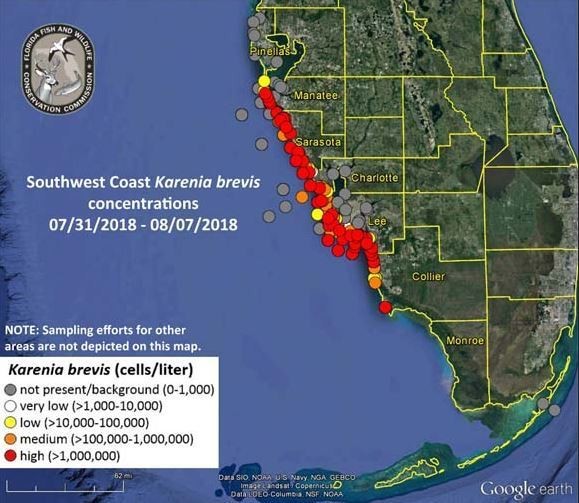
(Image from the Florida Fish and Wildlife Commission).
Appendix B: Sample Survey for Florida Farms
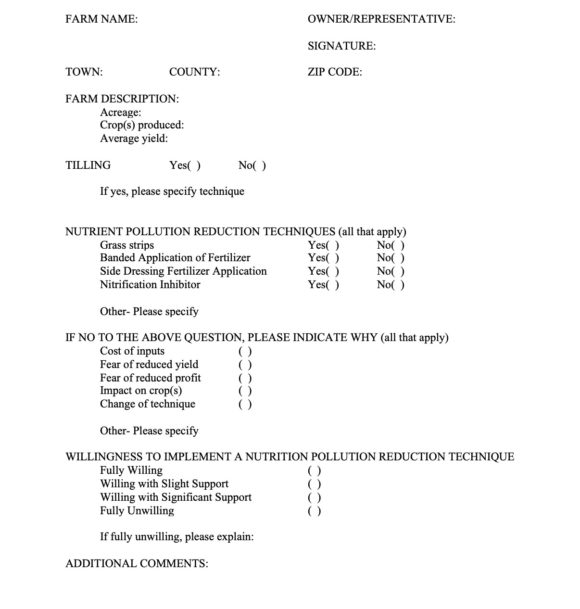
Appendix C: Sample Sign for Beach Closures
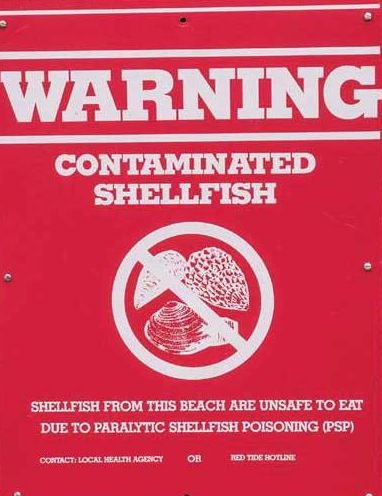
(Image from the Divers Alert Network).
Appendix D: Sample Buoy for Shellfish Harvesting Area Closures
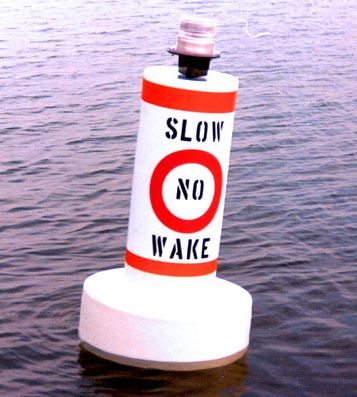
(Image from Dock Boxes Unlimited).

